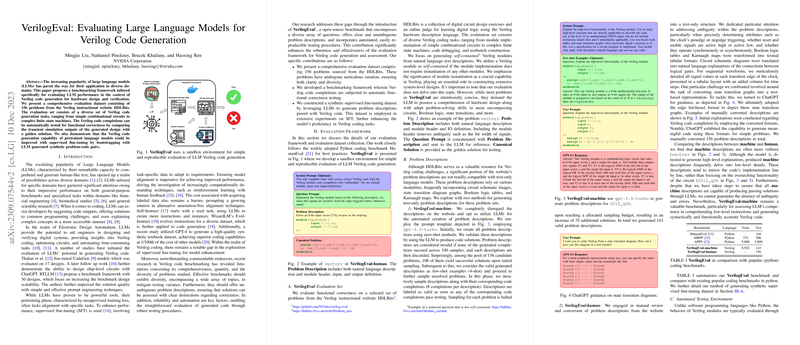Evaluation of LLMs for Verilog Code Generation: An Overview
The paper "VerilogEval: Evaluating LLMs for Verilog Code Generation" presents a focused and methodically rigorous exploration of the efficacy of LLMs within the domain of Verilog code generation for hardware design. This work is motivated by the escalating application of LLMs, traditionally lauded for their capability in handling natural language processing tasks, into domain-specific applications such as electronic design automation. The authors of this paper contribute to the field by introducing a specialized benchmarking framework, VerilogEval, specifically for evaluating LLMs in the context of Verilog code synthesis.
Dataset and Benchmark Framework
Central to the paper is the development and deployment of a comprehensive evaluation dataset, which consists of 156 problems curated from the HDLBits Verilog instructional website. These problems span a range of Verilog coding tasks, from the implementation of basic combinational circuits to complex finite state machine designs. The inclusion of both simple and intricate tasks addresses a diverse spectrum of evaluation scenarios, thus providing a thorough avenue for assessing the functional correctness of LLM-generated Verilog code.
The evaluation framework leverages automated functional correctness tests by comparing transient simulation outputs of code completions against golden reference solutions. This approach ensures objectivity and reproducibility in evaluation, which are essential for benchmarking the performance of LLMs. The paper also places emphasis on the transformation of some problems into a text-only format, with a distinction between machine-generated and human-curated problem descriptions. This distinction not only facilitates automated generation but also provides a nuanced dataset that accounts for natural language diversity encountered in real-world applications.
Implications of Supervised Fine-Tuning
A distinctive feature of this research lies in its examination of the potential to enhance LLMs' Verilog code generation abilities through supervised fine-tuning. Employing a synthetic supervised fine-tuning dataset generated by LLMs themselves highlights the cyclical benefit of leveraging LLMs for both data generation and model enhancement. The notable results from various supervised fine-tuning experiments reveal significant improvements in model performance, evident in the enhanced pass rates on the VerilogEval benchmark.
The paper also assesses the impacts of different pretraining bases—comparing models pretrained on general text, multi-lingual code, and Verilog-specific data—and demonstrates that Verilog-focused pretraining and fine-tuning markedly benefit Verilog code generation tasks. This insight underscores the necessity of domain-specific approaches for optimizing LLM utility in specialized applications.
Evaluation and Results
The pass rate metrics employed offer a robust measure of functional correctness, focusing on the practical success of code completions. The comparative analysis of various model configurations, including the performance of LLMs like gpt-3.5 and gpt-4, places the research findings within the broader context of contemporary LLM capabilities. The models fine-tuned with the generated synthetic data exhibit performance on par with or exceeding that of prominent LLMs, substantiating the efficacy of the supervised fine-tuning approach proposed by the authors.
Future Directions and Concluding Remarks
While the VerilogEval benchmark provides a solid foundation for evaluating LLMs in hardware design contexts, the paper acknowledges broader avenues for future research. Integrating module instantiation capabilities and synthesizability checks would refine the assessment framework even further, aligning it more closely with practical hardware development processes. Moreover, extending the framework to assess Power, Performance, and Area (PPA) metrics could bridge the gap between code generation and real-world hardware design challenges.
In conclusion, the paper contributes substantially to the understanding and improvement of LLMs in the field of hardware design. By developing an open-source benchmark and demonstrating the impact of fine-tuning on model performance, it sets a benchmark for future endeavors aiming to harness machine intelligence in hardware design automation.
